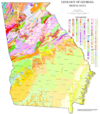User:Abyssal/Portal:Ordovician
IntroductionThe Ordovician (/ɔːrdəˈvɪʃi.ən, -doʊ-, -ˈvɪʃən/ or-də-VISH-ee-ən, -doh-, -VISH-ən) is a geologic period and system, the second of six periods of the Paleozoic Era, and the second of twelve periods of the Phanerozoic Eon. The Ordovician spans 41.6 million years from the end of the Cambrian Period 485.4 Ma (million years ago) to the start of the Silurian Period 443.8 Ma. The Ordovician, named after the Welsh tribe of the Ordovices, was defined by Charles Lapworth in 1879 to resolve a dispute between followers of Adam Sedgwick and Roderick Murchison, who were placing the same rock beds in North Wales in the Cambrian and Silurian systems, respectively. Lapworth recognized that the fossil fauna in the disputed strata were different from those of either the Cambrian or the Silurian systems, and placed them in a system of their own. The Ordovician received international approval in 1960 (forty years after Lapworth's death), when it was adopted as an official period of the Paleozoic Era by the International Geological Congress. Life continued to flourish during the Ordovician as it had in the earlier Cambrian Period, although the end of the period was marked by the Ordovician–Silurian extinction events. Invertebrates, namely molluscs and arthropods, dominated the oceans, with members of the latter group probably starting their establishment on land during this time, becoming fully established by the Devonian. The first land plants are known from this period. The Great Ordovician Biodiversification Event considerably increased the diversity of life. Fish, the world's first true vertebrates, continued to evolve, and those with jaws may have first appeared late in the period. About 100 times as many meteorites struck the Earth per year during the Ordovician compared with today in a period known as the Ordovician meteor event. It has been theorized that this increase in impacts may originate from a ring system that formed around Earth at the time. (Full article...) Selected article on the Ordovician world and its legacies
Starfish or sea stars are echinoderms belonging to the class Asteroidea. About 1,500 living species of starfish occur on the seabed in all the world's oceans, from the tropics to subzero polar waters. They are found from the intertidal zone down to abyssal depths, 6,000 m (20,000 ft) below the surface.
Starfishes typically have a central disc and five arms, though some species have more than this. The aboral or upper surface may be smooth, granular or spiny, and is covered with overlapping plates. Starfish have tube feet operated by a hydraulic system and a mouth at the centre of the oral or lower surface. They are opportunistic feeders and are mostly predators on benthicinvertebrates. Several species having specialized feeding behaviours including eversion of their stomachs and suspension feeding. They have complex life cycles and can reproduce both sexually and asexually. Most can regenerate damaged parts or lost arms and they can shed arms as a means of defence. The Asteroidea occupy several significant ecological roles. The fossil record for starfish is ancient, dating back to the Ordovician around 450 million years ago, but it is rather poor, as starfish tend to disintegrate after death. Only the ossicles and spines of the animal are likely to be preserved, making remains hard to locate. (see more...) Selected article on the Ordovician in human science, culture and economics
The geologic map of Georgia (a state within the United States) is a special-purpose map made to show geological features. Rock units or geologic strata are shown by colors or symbols to indicate where they are exposed at the surface. Structural features such as faults and shear zones are also shown. Since the first national geological map, in 1809, there have been numerous maps which included the geology of Georgia. The first Georgia specific geologic map was created in 1825. The most recent state-produced geologic map of Georgia, by the Georgia Department of Natural Resources is 1:500,000 scale, and was created in 1976 by the department's Georgia Geological Survey. It was generated from a base map produced by the United States Geological Survey. The state geologist and Director of the Geological Survey of Georgia was Sam M. Pickering, Jr. Since 1976, several geological maps of Georgia, featuring the state's five distinct geologic regions, have been produced by the federal government. (see more...)
Selected image
Did you know?
Need help?Do you have a question about Abyssal/Portal:Ordovician that you can't find the answer to? Consider asking it at the Wikipedia reference desk. TopicsEpochs - Early Ordovician - Middle Ordovician - Late Ordovician Landmasses - Baltica - Gondwana - Laurentia - Siberia Fossil sites - Beecher's Trilobite Bed - Walcott–Rust quarry Researchers - Charles Emerson Beecher - Charles Lapworth - Charles Doolittle Walcott Quality ContentFeatured Ordovician articles - None SubcategoriesRelated contentAssociated WikimediaThe following Wikimedia Foundation sister projects provide more on this subject:
|






















